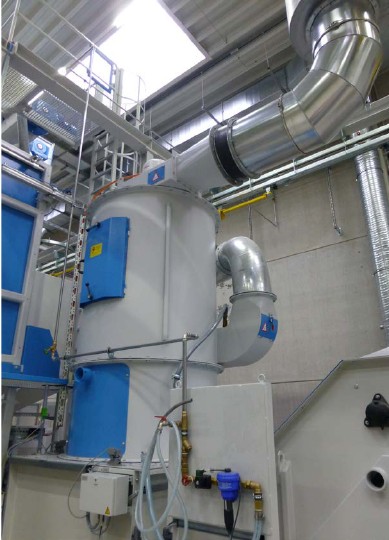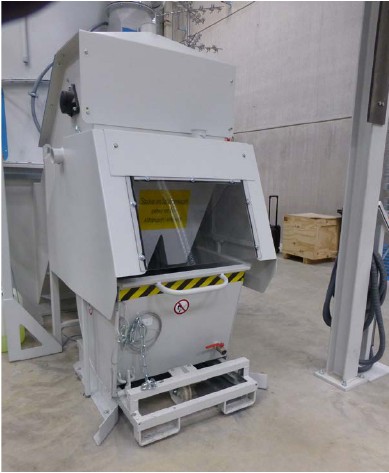Abschnitt 2.6 - 2.6 Blasting
The dust particles generated during blasting have a large surface area and, in addition to the risk of fire, can also lead to the formation of a hazardous explosive atmosphere. A fire occurs when deposited dust ignites. The ignition of even small quantities of whirled-up dust involves an explosion hazard.
Due to the high risk of explosion, the resulting dusts are passed through a wet scrubber and precipitated. This leads to a reaction of the magnesium particles with water which generates such an amount of hydrogen gas that the formation of an explosive mixture is possible. This is particularly critical if there is an insufficient quantity of water in the separator tank.
If the work clothes are soiled by dust, the employees are exposed to an increased risk of fire.

Figure 26
Wet scrubber
Protective measures
Copper-free aluminium or zinc wire grain or granulate or corundum (inerting effect with corundum content > 50 % of the blasting dust) should preferably be used as blasting medium.
Steel and cast iron should not be used as blasting media because of sparking and the increased risk of corrosion due to iron abrasion adhering to the magnesium parts. Iron oxides are also less suitable as blasting agents (e. g. ferrosate) due to the danger of aluminothermic reactions.
Basically, systems for blasting magnesium are extracted by means of a wet scrubber. The extracted air flow is permanently monitored during processing (pressure or flow meter: velocity extraction volume flow > 20 m/s). The piping must be equipped with inspection openings to allow for regular inspection and cleaning.
The wet scrubber has to be provided with vents so that any hydrogen produced can escape and cannot accumulate.
A continuous potential equalization (grounding from the blasting cabinet to the wet scrubber including lightning protection) must also be observed.
Cleaning in the vicinity of the blasting system must also be specified in a cleaning schedule. Magnesium-containing dust deposits may only be collected by approved industrial vacuum cleaners. For this purpose, suitable industrial vacuum cleaners without internal ignition sources (e. g. identification on the type plate: Type 22, EPL Dc [1]) and possibly with hydrogen venting must be used. The dust collection containers should be emptied every working day. Cleaning intervals and methods are to be documented in a cleaning schedule. For information on industrial vacuum cleaners and dust extractors, see DGUV Information 209-084 "Industriestaubsauger und Entstauber".
The extinguishing gases carbon dioxide or nitrogen must not be used when extinguishing magnesium fires at blasting systems. In general, the extinguishing gas should not be applied at high pressure in order to avoid whirling up the dust. The extinguishing gas or powder is applied gently.

Figure 27
Sludge tipper for magnesium deposits from wet scrubber
